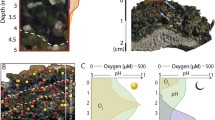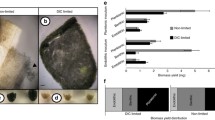Abstract
Cryptoendolithic (hidden in rock) lichen-dominated microbial communities from the Ross Desert of Antarctica were shown to produce oxalate (oxalic acid). Oxalate increased mineral dissolution, which provides nutrients, creates characteristic weathering patterns, and may ultimately influence the biological residence time of the community. Oxalate was the only organic acid detectable by HPLC, and its presence was verified by GC/MS. Community photosynthetic metabolism was involved in oxalate production since rates of 14C-oxalate production from 14C02 were higher in light than in dark incubations. Flaking of the sandstone at the level of the lichen-dominated zone a few millimeters beneath the rock surface can be explained by dissolution of the sandstone cement, which was enhanced by Si, Fe, and Al oxalate complex formation. Added oxalate was observed to increase the solubility of Si, Fe, Al, P, and K. Oxalate's ability to form soluble trivalent metal-oxalate complexes correlated with the observed order of metal oxide depletion from the lichen-dominated zone (Mn > Fe > Al). Thermodynamic calculations predict that Fe oxalate complex formation mobilizes amorphous Fe oxides (ferrihydrite) in the lichen-dominated zone, and where oxalate is depleted, ferrihydrite should precipitate. Hematite, a more crystalline Fe oxide, should remain solid at in situ oxalate concentrations. Oxalate was not a carbon source for the indigenous heterotrophs, but the microbiota were involved in oxalate mineralization to CO2, since oxalate mineralization was reduced in poisoned incubations. Photooxidation of oxalate to C02 coupled with photoreduction of Fe(Ill) may be responsible for oxalate removal in situ, since rates of 14C-oxalate mineralization in dark incubations were at least 50% lower than those in the light. Removal of oxalate from Si, Fe, and Al complexes should allow free dissolved Si, Fe, and Al to precipitate as amorphous silicates and metal oxides. This may explain increased siliceous crust (rock varnish or desert varnish) formation near the surface of colonized rocks were light intensity is greatest.
Similar content being viewed by others
References
Bennett AR, Hindal DF (1989) Mycelial growth and oxalate production by five strains of Cryphoectria parasitica in selected liquid culture media. Mycologia 81(4):554–560
Bennett JH, Lee EH, Krizek DT, Olsen RA, Brown JC (1982) Photochemical reduction of Fe(III). Plant related factors. J Plant Nutr 5(4–7):335–344
Bennett PC, Melcer ME, Siegel DI, Hassett JP (1988) The dissolution of quartz in dilute aqueous solutions of organic acids at 25°C. Geochim Cosmochim Acta 52:1521–1530
Brown DS, Allison JD (1987) MintegAl, an equilibrium metal speciation model: user's manual. (EPA/600/3–87/012) US Environmental Protection Agency, Washington DC
Curtiss B, Adams JB, Ghiorso MS (1985) Origin, development, and chemistry of silica-alumina rock coatings from the semi-arid regions of the island of Hawaii. Geochim Cosmochim Acta 49:49–56
Dorn RI, Oberlander TM (1981) Microbial origin of desert varnish. Science 213:1245–1247
Drever JI (1988) The geochemistry of natural waters. Prentice Hall, Inc., Englewood Cliffs, New Jersey
Eckhardt FEW (1985) Solubilization, transport, and deposition of mineral cations by microorganisms. In: Drever JI (ed) The chemistry of weathering. D Reidel Publishing Company, Norwell, MA, pp 161–173
Espejo E, Agosin E (1991) Production and degradation of oxalic acid by brown rot fungi. Appl Environ Microbiol 57:1980–1986
Felmy AR, Girvin DC, Jenne EA (1983) MINTEQ-A computer program for calculating aqueous geochemical equilibria. (Final Report, EPA contract 68–03–3089) US Environmental Protection Agency, Washington DC
Fox TR, Comerford NB (1990) Low-molecular-weight organic acids in selected forest soils of the southeastern USA. Soil Sci Soc Am J 54:1139–1144
Freidmann EI (1982) Endolithic microorganisms in the Antarctic cold desert. Science 215:1045–1053
Friedmann EI, Kibler AP (1980) Nitrogen economy of endolithic microbial communities in hot and cold deserts. Microb Ecol 6:95–108
Friedmann EI, Ocampo-Friedmann R (1976) Endolithic blue-green algae in the dry valleys: primary producers in the Antarctic desert ecosystem. Science 193:1247–1249
Friedmann EI, Weed R (1987) Microbial tracefossil formation, biogenous, and abiotic weathering in the Antarctic cold desert. Science 236:703–705
Friedmann EI, McKay CP, Nienow JA (1987) The cryptoendolithic microbial environment in the Ross Desert of Antarctica: satellite-transmitted continuous nanoclimate data, 1984–1986. Polar Biol 7:273–287
Friedmann EI, Hua M, Ocampo-Friedmann R (1988) Cryptoendolithic lichen and cyanobacteria communities of the Ross Desert, Antarctica. Polarforschung 58:251–259
Furrer G, Stumm W (1986) The coordination chemistry of weathering. I. Dissolution kinetics of delta-Al2O3 and BeO. Geochim Cosmochim Acta 50:1847–1860
Grandstaff DE (1986) The dissolution rate of forsteritic olivine from Hawaiian beach sand. In: Colmant SM, Dethier DP (eds) Rates of chemical weathering of rocks and minerals. Academic Press, Inc., Orlando, pp 41–59
Graustein WC, Cromack K, Sollins P (1977) Calcium oxalate: occurrence in soils and effect on nutrient and geochemical cycles. Science 198:1252–1254
Greenfield LG (1988) Forms of nitrogen in Beacon sandstone rocks containing endolithic microbial communities in southern Victoria Land, Antarctica. Polarforschung 58:211–218
Johnston CG, Vestal JR (1986) Does iron inhibit cryptoendolithic microbial communities? Ant J U.S. 21:225–226
Johnston CG, Vestal JR (1989) Distribution of inorganic species in two Antarctic cryptoendolithic communities. Geomicrobiol J 7:137–153
Johnston CG, Vestal JR (1991) Photosynthetic carbon incorporation and turnover in Antarctic cryptoendolithic microbial communities: are they the longest living communities on earth? Appl Environ Microbiol 57:2308–2311
Knaebel DB, Vestal JR (1988) A comparison of double vial to serum bottle radiorespirometry to measure microbial mineralization in soils. J Microbiol Meth 7:309–317
Kubicek CP, Schreferl-Kunar G, Wohrer W, Rohr M (1988) Evidence for a cytoplasmic pathway of oxalate biosynthesis in Aspergillus niger. Appl Environ Microbiol 54:633–637
Lopez-Hernandez D, Siegert G, Rodriguez JV (1986) Competitive adsorption of phosphate with malate and oxalate by tropical soils. Soil Sci Soc Am J 50:1460–1463
Manley EP, Evans LJ (1986) Dissolution of feldspars by low-molecular-weight aliphatic and aromatic acids. Soil Sci 141:106–112
Martell AE, Smith RA (1977) Other organic ligands. (Critical stability constants, vol 3) Plenum Press, New York
Mast MA, Drever JI (1987) The effect of oxalate on the dissolution rates of oligoclase and tremolite. Geochim Cosmochim Acta 51:2559–2568
Mehta A, Datta A (1991) Oxalate decarboxylase from Collybia velutipes: purification, characterization, and cDNA cloning. J Biol Chem 266:35:23548–23553
Nienow JA, McKay CP, Friedmann EI (1988) The cryptoendolithic microbial environment in the Ross Desert of Antarctica: light in the photosynthetically active region. Microb Ecol 16:271–289
Palmer RJ Jr, Friedmann EI (1990) Water relations and photosynthesis in the cryptoendolithic microbial habitat of hot and cold deserts. Microb Ecol 19:111–118
Palmer RJ, Siebert J, Hirsch P (1991) Biomass and organic acids in sandstone of a weathering building: production by bacterial and fungal isolates. Microb Ecol 21:253–266
Petrovich R (1981) Kinetics of dissolution of mechanically comminuted rock-forming oxides and silicates. I. Deformation and dissolution of quartz under laboratory conditions. Geochim Cosmochim Acta 45:1665–1674
Staley IT, Palmer F, Adams JB (1982) Microcolonial fungi: common inhabitants on desert rocks? Science 215:1093–1095
Stumm W, Furrer G, Wieland E, Zinder B (1985) The effects of complex-forming ligands on the dissolution of oxides and aluminosilicates. In: Drever JI (ed) The chemistry of weathering. D Reidel Publishing Company, Norwell, MA
Surdam RC, Crossey LJ, Hagen ES, Heasler HP (1989) Organic-inorganic interactions and sandstone diagenesis. Am Assoc Petrol Geol Bull 73(1)1–23
Ugolingi FC (1986) Processes and rates of weathering in cold and polar desert environments. In: Colmant SM, Dethier DP (eds) Rates of chemical weathering of rocks and minerals. Academic Press, Inc., Orlando, pp 193–235
Vestal JR (1988) Carbon metabolism of the cryptoendolithic microbiota from the Antarctic desert. Appl Environ Microbiol 54:960–965
Vestal JR, White DC (1989) Lipid analysis in microbial ecology. Bioscience 39:535–541
Weed R, Norton SA (1991) Siliceous crusts, quartz rinds, and biotic weathering of sandstones in the cold desert of Antarctica. In: Berthelin J (ed) Diversity of environmental biogeochemistry. (Developments in geochemistry, vol. 6) Elsevier, Amsterdam, pp 327–339
Zinder B, Furrer G, Stumm W (1986) The coordination chemistry of weathering. II. Dissolution of Fe(III) oxides. Geochim Cosmochim Acta 50:1861–1869
Zuo Y, Holgne J (1992) Formation of hydrogen peroxide and depletion of oxalic acid in atmospheric water by photolysis of iron(III)-oxalato complexes. Environ Sci Technol 26:1014–1022
Author information
Authors and Affiliations
Additional information
Offprint requests to: C.G. Johnston.
Rights and permissions
About this article
Cite this article
Johnston, C.G., Vestal, J.R. Biogeochemistry of oxalate in the antarctic cryptoendolithic lichen-dominated community. Microb Ecol 25, 305–319 (1993). https://doi.org/10.1007/BF00171895
Received:
Revised:
Issue Date:
DOI: https://doi.org/10.1007/BF00171895




